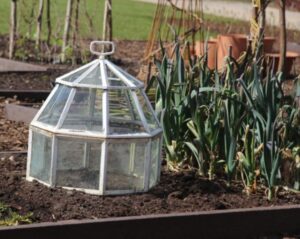What the Heck Is a Cloche? Does My Garden Need One?

What do a stylish woman’s hat and a tool to extend your garden’s growing season have in common? The answer: Both are cloches. If you’re a fan of 1920s period dramas (think “Downton Abbey”) then you’ve seen women wearing cloche hats that mold around the head in an elegant bell shape. A garden cloche is a slightly less elegant device, though worthy in its own right, that covers plants and allows you to extend your growing season by creating a warmer micro-climate.
A short history lesson
Cloche (kl-osh, pronounced like gauche or skosh) is a French word that means bell. Centuries ago, they were made of glass and looked like bell jars. Just like today, gardeners placed the cloche over individual plants to extend the growing season by protecting them from cold temperatures. Although they were very elegant, the problem with these glass cloches is that they often got too hot and baked the tender plants that they were covering. Therefore, gardeners had to prop them up with a small piece of wood to allow for ventilation.
Reportedly, these glass cloches can still be found at flea markets; I’ve never been lucky enough to find one.
What a cloche is NOT
A cloche is similar to, but not the same as, a greenhouse, a hoop house, or a cold frame. The commonality is that all of these devices extend your garden’s growing season. The differences aren’t so clear-cut, but (very) broadly speaking a cloche is smaller. Because of its small size, it is more portable but won’t cover as many plants.
Why you want a cloche
If you live in an area of the country that has cool weather, you want a cloche to extend your growing season. You can count on getting a few weeks at the beginning and end (spring and fall) of your growing season with a cloche. For gardeners in any climate, a cloche will help prevent heavy rain and wind from beating on your plants.
Many different options
Over the years, gardeners have been creative and developed a variety of cloche options. Bear in mind that because of their smaller size, it may take a number of cloches to protect your garden plants. Count on one cloche protecting one to three plants. Here are the most popular options:
Umbrella cloche
These funky contraptions are exactly what their name suggests. They’re clear plastic umbrella-shaped plant coverings that have a center rod (just like an umbrella) that roots the cloche in the ground. They’re great because they’re light weight, portable, and usually have ventilation. The downside is that I’ve only ever seen them available to buy online.
Tent cloche
A tent cloche looks a lot like a pup tent with two angled sides that meet at a center point; the ends are open to allow for ventilation. They are a great option because you can easily make your own. If you have two old windows hanging around, prop them up against a center pole to make a recycled tent cloche. Alternatively, pound two pieces of wood (3-4 feet long) in the ground a couple feet apart and drape a piece of clear plastic over to make a cloche; anchor the plastic to the ground with a couple stones.
Tunnel cloche
A tunnel cloche bears so much resemblance to a hoop house that I have a hard time telling them apart.
You can make your own out of plastic PVC pipe and clear plastic covering. Check out this guide for detailed instructions. I’ve seen some gardeners use cedar branches instead of PVC pipe, which is a nifty idea because it’s cheaper (if you have a cedar tree) and biodegradable.
Barn cloche
A barn cloche is a more elaborate type of cloche that looks a lot like a small greenhouse. They vary in size, but I think of them as a greenhouse that an American Girl doll (18 inches tall) might use. Find them at a garden store or through online retailers; many come in ready-to-assemble kits.
Reused plastic packaging cloche (a.k.a. down-and-dirty keep-it-simple cloche)
For years I’ve had a love-hate relationship with those plastic boxes that my baby greens came in. I loved that they protected my greens, but I hated the plastic that was used. Now, I have a better relationship with them because I reuse them to cover my most tender garden plants. Use garden stakes to secure them to the ground, or a couple of rocks placed on top will do the trick.
Another option is to cut the bottom off of a plastic gallon milk jug. I’ve even heard of some folks using an empty plastic peanut butter jar as a cloche. (Make your dog happy and let her lick the inside clean.)
Related on Organic Authority
What the Herb Is a Garden Cloche?
Greenhouse Grown: The Future of Local Produce?
8 Tips for Growing A Greenhouse Organic Vegetable Garden
photo of garden cloche via Shutterstock

